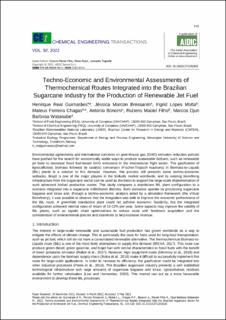| dc.contributor.author | Guimarães, Henrique Real | |
| dc.contributor.author | Bressanin, Jéssica Marcon | |
| dc.contributor.author | Motta, Ingrid Lopes | |
| dc.contributor.author | Chagas, Mateus Ferreira | |
| dc.contributor.author | Bonomi, Antonio | |
| dc.contributor.author | Filho, Rubens Maciel | |
| dc.contributor.author | Barbosa Watanabe, Marcos Djun | |
| dc.date.accessioned | 2023-02-14T15:22:07Z | |
| dc.date.available | 2023-02-14T15:22:07Z | |
| dc.date.created | 2022-10-04T09:23:41Z | |
| dc.date.issued | 2022 | |
| dc.identifier.citation | Chemical Engineering Transactions. 2022, 92 115-120. | en_US |
| dc.identifier.issn | 1974-9791 | |
| dc.identifier.uri | https://hdl.handle.net/11250/3050833 | |
| dc.description.abstract | Environmental agreements and international concerns on greenhouse gas (GHG) emission reduction policies have pushed for the search for economically viable ways to produce sustainable biofuels, such as renewable jet fuels to decrease fossil fuel-based GHG emissions in the international flight sector. The gasification of lignocellulosic biomass followed by catalytic conversion (Fischer-Tropsch reactions) in Biomass-to-Liquids (BtL) plants is a solution to this demand. However, this process still presents some techno-economic setbacks. Brazil is one of the major players in the biofuels market worldwide, and its existing biorefining infrastructure from the sugarcane sector can be used as the basis to support the large-scale implementation of such advanced biofuel production routes. This study compares a standalone BtL plant configuration to a scenario integrated into a sugarcane mill/ethanol distillery. Both scenarios operate by processing sugarcane bagasse and straw and, through a techno-economic analysis aided by a simulation framework (the Virtual Biorefinery), it was possible to observe that the integration was able to improve the economic performance of the BtL route. A greenfield standalone plant could not achieve economic feasibility, but the integrated configuration achieved internal rates of return of 10-12% per year. Some aspects may improve the viability of BtL plants, such as logistic chain optimizations to reduce costs with feedstock acquisition and the consideration of environmental policies and incentives to help increase revenue. | en_US |
| dc.language.iso | eng | en_US |
| dc.publisher | AIDIC | en_US |
| dc.title | Techno-Economic and Environmental Assessments of Thermochemical Routes Integrated into the Brazilian Sugarcane Industry for the Production of Renewable Jet Fuel | en_US |
| dc.title.alternative | Techno-Economic and Environmental Assessments of Thermochemical Routes Integrated into the Brazilian Sugarcane Industry for the Production of Renewable Jet Fuel | en_US |
| dc.type | Peer reviewed | en_US |
| dc.type | Journal article | en_US |
| dc.description.version | publishedVersion | en_US |
| dc.source.pagenumber | 115-120 | en_US |
| dc.source.volume | 92 | en_US |
| dc.source.journal | Chemical Engineering Transactions | en_US |
| dc.identifier.doi | 10.3303/CET2292020 | |
| dc.identifier.cristin | 2058173 | |
| cristin.ispublished | true | |
| cristin.fulltext | original | |
| cristin.qualitycode | 1 | |
